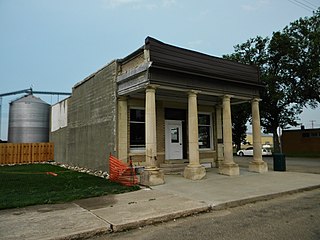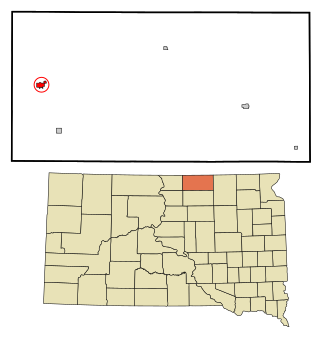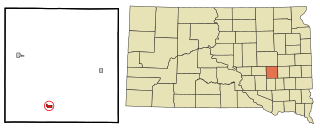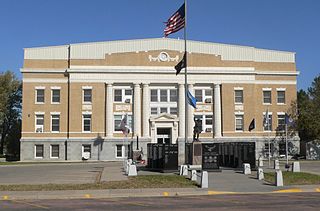
Columbia is an incorporated small town on the James River in Brown County, South Dakota, United States. The population was 160 at the 2020 census. There is a large granary co-op at Columbia, also a post office, a bank, a bar, a church, a town park, and a community center, in addition to the city hall; and many homes.

Chamberlain is a city in Brule County, South Dakota, United States. It is located on the east bank of the Missouri River, at the dammed section of the Lake Francis Case, close to where it is crossed by Interstate 90.

Newell is a city in Butte County, South Dakota, United States. The population was 584 at the 2020 census.

Wagner is a city in Charles Mix County, South Dakota, United States. The population was 1,490 at the 2020 census. The city is served by Wagner Municipal Airport as well as YST Transit buses.

Garden City is a town in Clark County, South Dakota, United States. The population was 33 at the 2020 census.

Webster is a city in and the county seat of Day County, South Dakota, United States. The population was 1,728 at the 2020 census.

Bowdle is a city in Edmunds County, South Dakota, United States. The population was 470 at the 2020 census.

Hosmer is a city in northwestern Edmunds County, South Dakota, United States. The population was 164 at the 2020 census.

Ipswich is a city in and county seat of Edmunds County, South Dakota, United States. The population was 928 at the 2020 census.

Roscoe is a city in central Edmunds County, South Dakota, United States. The population was 269 at the 2020 census.

Gregory is a city in western Gregory County, South Dakota, United States. The population was 1,221 at the 2020 census.

Parkston is a city in Hutchinson County, South Dakota, United States. The population was 1,567 at the 2020 census.

Murdo is a city in and the county seat of Jones County, South Dakota, United States. The population was 475 at the 2020 census.

Whitewood is a city in Lawrence County, South Dakota, United States. The population was 879 at the 2020 census.

Lennox is a city in Lincoln County, South Dakota, United States, located 20 miles (32 km) southwest of Sioux Falls. The population was 2,423 at the 2020 census.

Tea is a city in Lincoln County, South Dakota, United States and is a suburb of Sioux Falls. The population was 5,598 at the 2020 census, and was estimated to be 7,381 in 2023.

Eureka is a city in western McPherson County, South Dakota, United States, near the North Dakota state line. The population was 813 at the 2020 census.

Letcher is a town in Sanborn County, South Dakota, United States. The population was 159 at the 2020 census.

Winner is a city in central Tripp County, South Dakota, United States. The population was 2,921 at the 2020 census. It is the county seat of Tripp County. Winner also serves as the administrative center of neighboring Todd County, which does not have its own county seat. The nearest airport is Winner Regional Airport.

Elk Point is a city in and the county seat of Union County, South Dakota, United States. The population was 2,149 as of the 2020 census.





















